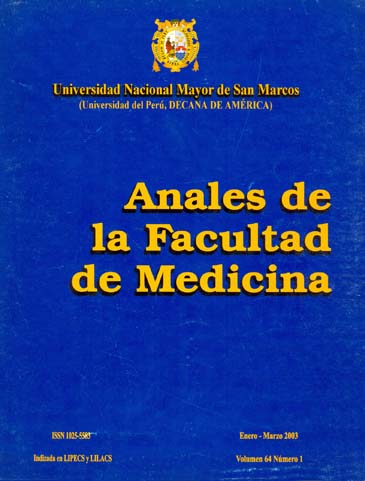Study of the central auditive pathway by encephalic trunk evoked e auditory responses (ear) in children with language retard
DOI:
https://doi.org/10.15381/anales.v64i1.1417Keywords:
Language development disorders, evoked potentials, auditory, brain stem, auditory pathways.Abstract
Objetive: To determine the functional integrity of the brainstem auditory pathway by the auditive brainstem response (ABR) in language-retarded children without pathology in both the middle ear and central nervous system and no neonatal hearing loss risk factors. Design: Retrospective transversal study. Setting: Naval Medical Center and Air Force Central Hospital Otorhinolaryngology Services, Lima. Peru. Material and methods: Analysis of children’s ABR performed in the last ten years included 48 children, 28 males and 20 females, 1 to 11 year-old. Main outcome measures were both latency time and morphology of waves I, II, III, IV, and V. Results: Latencies were normal at any age. Morphological distortion and/ or wave hypovoltage were found in 77% of the patients, more frequently (58%) in waves I and II that correspond to the auditory nerve and brainstem cochlear nuclei. Conclusions: The results suggest a disturbance in the neural synchronization of the auditory pathway and the brainstem nuclei in 77% of the patients studied, that would affect the central auditory processing.Downloads
Published
2003-03-17
Issue
Section
Trabajos originales
License
Copyright (c) 2003 Manuel Gallardo, Carlos Vera

This work is licensed under a Creative Commons Attribution-NonCommercial-ShareAlike 4.0 International License.
Those authors who have publications with this magazine accept the following terms:
- Authors will retain their copyrights and guarantee the journal the right of first publication of their work, which will be simultaneously subject to Creative Commons Attribution License that allows third parties to share the work as long as its author and its first publication this magazine are indicated.
- Authors may adopt other non-exclusive licensing agreements for the distribution of the version of the published work (eg, deposit it in an institutional electronic file or publish it in a monographic volume) provided that the initial publication in this magazine is indicated.
- Authors are allowed and recommended to disseminate their work over the Internet (eg: in institutional telematic archives or on their website) before and during the submission process, which It can produce interesting exchanges and increase quotes from the published work. (See El efecto del acceso abierto ).
How to Cite
1.
Gallardo M, Vera C. Study of the central auditive pathway by encephalic trunk evoked e auditory responses (ear) in children with language retard. An Fac med [Internet]. 2003 Mar. 17 [cited 2025 May 31];64(1):27-33. Available from: https://revistasinvestigacion.unmsm.edu.pe/index.php/anales/article/view/1417



